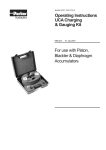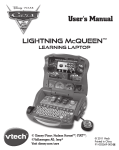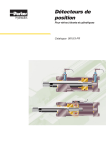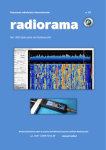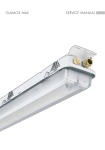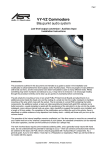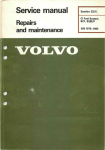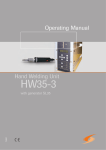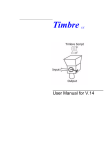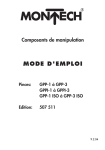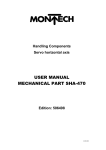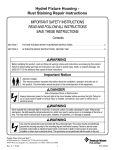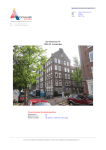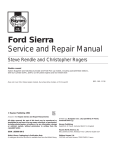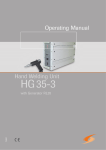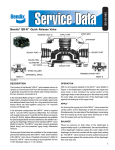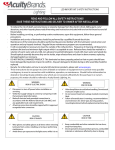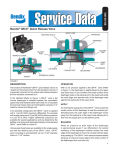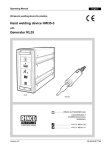Download Hydraulic Cylinder Troubleshooting
Transcript
Hydraulic Cylinder Troubleshooting Avoiding Rod Seal Leakage and Premature Wear Bulletin 1242/1-GB The industrial world has altered its perception of hydraulic cylinders. Piston rod seal leaks even small ones are no longer acceptable. Today’s applications demand that, after any necessary ‘running in’, the piston rod should show no ring of oil. That demand can be met by understanding and applying the following principles. Most rod seal leaks are caused by: ● a damaged rod or rod bearing ● contaminated fluid ● temperature extremes ● chemical attack ● high pressure ● low pressure Damaged Piston Rods or Rod Bearings Damaged piston rods or rod bearings are the most common cause of rod seal failure. The usual causes of such damage are poor alignment between the cylinder and its load, resulting in side loading; or a bent piston rod, resulting from the use of an undersized rod in a thrust application. Cylinders are designed to provide linear force and motion to a guided load. The path which the guided load travels must not impose a significant eccentric load on the rod or the piston rod bearing, or the bearing surfaces will be damaged and fluid leakage and reduced bearing life will result. The maximum thrust force which a cylinder should provide is limited by its rod diameter and overall length. In long-stroke cylinders, care should be taken to ensure that the piston rod is capable of handling the thrust forces generated in the application, and that the cylinder is adequately supported. Note, also, that a head end mounting style will provide greater column strength than a cap end mounting, due to the smaller distance between mounting points. Full guidance for piston rod size selection is contained in Parker’s hydraulic cylinder product catalogues. SYMPTOMS: Rod seals and bearings are worn on one side only (Fig. 1). Piston rods and cylinder tubes are worn or galled on opposite sides, particularly at or near full extension (Fig. 2). Piston rods should be straight within 0.15mm per metre; T.I.R. and surface finishes should be below 0.4 microns R.M.A. SOLUTION: There is no substitute for precision in machine alignment. Alignment couplers, spherical bearings and floating flanged rod ends may help in some applications, but they 1 Fig.1 Gland and seal showing wear resulting from excessive side loading. Brass ‘paste’ on seal is a mixture of gland material and hydraulic fluid. often require larger diameter piston rods or longer stop tube lengths to make up for the higher bearing stresses caused by the loss of rigidity between the piston rod and its moving load. Parker cylinders are available with substantial load bearing capabilities, and severe failures of components indicate the need for a thorough review of the application. The load bearing capabilities of rod bearings are also influenced by their material. Extremely hard rod bearings are more likely than soft bearing materials to cause damage to the piston rod itself. Some manufacturers employ a hard bearing material because the relative positions of the seal and the rod bearing cause the bearing to run fairly dry. The trade-off is between risk of damage to the rod vs. damage to the rod bearing. A new piston rod is a made-to-order part and replacement requires a complete stripdown and rebuild of the cylinder. A new rod gland and bearing is a stock item and is easily replaced. Parker’s rod bearing and seal cartridge design has a flooded bearing surface that does not run ‘dry’; is easily replaceable, and is made of a material that provides long life when correctly mounted and aligned. To improve the support available to long stroke cylinders, the use of additional mountings and tie rod supports should be considered. Fig.2 Galling on this piston rod is evidence of excessive side loading. Contaminated Fluid Contaminated fluid can also cause premature rod seal failure. Abrasive particles suspended in the fluid can damage the seal and the piston rod surface, while airborne contamination can be drawn into a cylinder via a faulty wiper seal. Water is a common contaminant in mineral oil systems, affecting the lubricity of the fluid and causing some of the most widely used seal materials to ‘age harden’ at temperatures above 65°C. Polyurethane seals are subject to hydrolysis effects in high waterbased fluids at temperatures above 50°C, leading to a loss of Fig.3 Contamination damage is apparent in this rod seal, where the serrations are worn completely away. The seal on the right is a new one, shown for comparison. high cycling speeds can cause air bubbles to become highly charged with heat energy, a condition often referred to as ‘dieselling’. This condition is particularly pronounced in vertical, rod-up applications where a rapid increase in hydraulic hardness and tensile strength which allows fluid leakage from the rod seal. Air is often overlooked as a fluid contaminant, but aerated oil can cause physical damage to piston rod seals. Pressure shocks in systems with 2 pressure can cause intense, localised heating of the bubbles at the lip of the primary seal. The presence of air in the fluid can also intensify the transmission of vibration which, in turn, can lead to other forms of system failure. (continued) Contaminated Fluid SYMPTOMS: Moderate to extreme leakage, with hydrostatic leakage. Particle contamination appears as score marks on the seal (Fig. 3) and rod bearing, and on the cushion sleeve (Fig. 4). Water in the oil may cause some seal materials to crumble or disintegrate at high temperatures (Fig. 7). Air bubble damage appears as small score marks on the inner surface of the high pressure side of the seal, and the heel of the seal may appear to be ‘nibbled’ (Fig. 5). The trumpet-shaped score is caused by expansion of the bubble as it works its way through the seal. Air bubbles may also attack the outer diameter lip of a rod seal, or may burn a hole through the heel of the seal. Fig.4 Particle contamination has scored the surface of this cushion bush, resulting in loss of cushioning effect. (continued) SOLUTION: Particle contamination may be reduced through appropriate filtration methods, provided the fluid circulates from the cylinder to the reservoir in an efficient manner. To determine if a cylinder will efficiently flush oil and contaminants to the reservoir, compare the volume of oil contained in the cylinder to the volume of oil contained in the hose between the cylinder port and the directional control valve. If the hose holds more oil than the cylinder, particle contamination probably will not flow to the reservoir to be filtered out. Instead, it will remain in the cylinder and scour the seals. One solution is to relocate the directional valve closer to the cylinder to reduce the line volume to less than that of the cylinder. This allows oil to be flushed from the cylinder to the reservoir, to be filtered and cooled. Other solutions to particle and water contamination include the installation of metal rod scrapers or rod bellows to slow the ingress of contaminants. Paying close attention to the alignment of the cylinder on installation will also reduce the rate at which the cylinder produces its own fluid contaminants (Fig. 1). All hydraulic oil contains dissolved air. Dissolved air cannot be bled out, and, in fact, does not cause a problem. The symptoms described above occur when air comes out of solution in the form of bubbles. Conditions that cause air to come out of solution are: rapid decompression, high flow through an undersized port (turbulent flow) or over-running loads. If a cylinder that was properly installed and bled continues to have problems with air, ie: if it seems to ‘generate’ air, it is likely that one of these three conditions is occurring. This is particularly true of applications involving water glycol fluids, since these are capable of dissolving more air than mineral oil fluids. 3 Fig.5 Piston seals damaged by air in oil. Extreme Temperatures Extreme temperature applications pose two challenges. First, the temperature itself may limit the choice of seal materials and geometries, eg: polyurethane seals should be restricted to a maximum of 50°C, in order to avoid hydrolysis of the seal compound. Second, the fluids used in such applications often have less lubricity than mineral oil-based fluids. SYMPTOMS: Seals that have been overheated or exposed to too low a temperature have the same appearance: hard, cracked and brittle (Fig. 6). SOLUTION: Parker cylinders are available with high and low temperature seal options. In some applications, temperature control of the cylinders or oil must be provided to ensure effective operation. Fig.6 The cracked outer sealing lip of this wiper seal shows damage caused by heat. 4 Chemical Attack Some fluids react with seal materials and attack them chemically. Fluid manufacturers often list common seal materials as ‘compatible’ without defining the suitability of the material for a dynamic seal. It may be acceptable for a static seal such as a cylinder body O-ring to swell by 10% but, if a dynamic rod seal swells by 10%, the result can be a dramatic rise in friction and accelerated wear. One common mineral oilbased fluid has an additive that shrinks a widely-used seal material by 10%. Again, the result is a leak, particularly in dynamic applications. SYMPTOMS: Seals feel sticky or gummy in some cases, or may appear dry and cracked (Fig. 7). Shrunken seals may rattle in their cartridge grooves, while swollen seals may prove difficult to remove from the cylinder. SOLUTION: Ask your Parker representative for his recommendations for a particular fluid. He will consult with the fluid manufacturer and seal supplier to resolve the problem. Often, a simple test can be performed to determine the effects of a particular fluid/seal combination. Fig.7 Before and after. This polypak rod seal has been damaged by water, a common contaminant in mineral oil systems. SOLUTION: If excessive pressure is caused by intensification due to a flow restriction, the restriction should be removed. If the condition persists, a special gland and seal design should be Fig.8 Wiper seal showing high pressure extrusion damage. High Pressure Leaks This type of leakage is rarely encountered with the latest generation of polyurethane seals. With rod seals of other materials, high pressure leakage is usually the result of inadvertent pressure intensification across the piston. A severe meter-out flow restriction at the head end of a cylinder with an oversized piston rod can expose the rod seal to a back pressure equal to twice the system pressure. Continued operation under these conditions can cause rapid seal wear due to excess friction, extrusion of the primary seal or, in extreme cases, failure of the rod cartridge or the retainer. SYMPTOMS: Extreme amounts of leakage occur. Rod seals may be worn uniformly around their entire inner sealing surface. Extrusion damage manifests itself as ‘flash’ or feathered edges at the inner diameter of the heel of the seal (Fig. 8). Mechanical failure of seal support lands in rod cartridges or of cartridge retainer bolts can also occur. 5 considered to reduce the extrusion gap, permitting the seal to withstand the high pressures. Low Pressure Leaks Problems with leakage at low operating pressures are uncommon with polyurethane rod seals due to their low energising pressure requirement. With other classes of rod seal material, low pressure leaks may occur in applications that have no meter-out flow control at the rod end of the cylinder. With the rod extending, the drive pressure may be 200 bar, but the back pressure in the cylinder may be less than 20 bar. Some elastomeric lipseals require a minimum pressure level to become fully energised, and only work at full efficiency with back pressures above 30 bar. Below that level, the seal may hydroplane and fail to seal against the rod surface. SYMPTOMS: The rod runs ‘wet’, with a collar of oil. The rod wiper may extrude, (Fig. 9) but the primary rod seal is undamaged (Fig. 9, inset) so that no leakage occurs when the cylinder is hydrostatically tested. This condition should not be confused with the ‘running in’ period required by some low friction seals, which may not give full dry rod performance until around 100 cycles have been completed. Fig.9 The rod wiper may extrude (top) but the primary rod seal looks perfect (right), so no leakage occurs when the cylinder is hydrostatically tested. SOLUTION: Raise the back pressure to above 30 bar, or substitute a rod seal with better low pressure sealing characteristics. Note that some ‘loaded’ seals may exhibit excessive friction levels or may otherwise disrupt the normal operation of a primary and secondary sealing system. Conclusions The key to a successful ‘dry rod’ cylinder application is the ability to control or eliminate undesirable conditions, or to select a cylinder with rod seals that can tolerate those conditions. While there is no ‘universal’ seal, Parker’s engineers will help you to select the right combination of seals and rod bearing materials to ensure dry rod performance and long service life in your application. 6 Cylinder Division Sales Offices Austria – Vienna Parker Hannifin GmbH Tel: 1332/36050 Fax: 1332/360577 Netherlands – Oldenzaal Parker Hannifin N.V. Tel: (541) 585000 Fax: (541) 585459 Belgium – Brussels S.A. Parker Hannifin N.V. Tel: (02) 762 18 00 Fax: (02) 762 33 30 Norway – Langhus Parker Hannifin A/S Tel: (64) 86 77 60 Fax: (64) 86 68 88 Czech Republic – Prague Parker Hannifin Corporation Tel: 2 6134 1704 Fax: 2 6134 1703 Poland – Warsaw Parker Hannifin Corp. Tel: (22) 863 49 42 Fax: (22) 863 49 44 Denmark – Ishøj Parker Hannifin Danmark A/S Tel: 43 54 11 33 Fax: 43 73 31 07 Spain – Madrid Parker Hannifin Espana S.A. Tel: (1) 675 73 00 Fax: (1) 675 77 11 Finland – Vantaa Parker Hannifin Oy Tel: 0 9 476 731 Fax: 0 9 476 73200 Sweden – Spånga Parker Hannifin Sweden AB. Tel: 08-761 29 60 Fax: 08-761 81 70 France – Contamine-sur-Arve Parker Hannifin RAK S.A. Tel: 4 50 25.80.25 Fax: 4 50 03.67.37 Switzerland – Romanshorn Hydrel A.G. Romanshorn Tel: (714) 61 11 11 Fax: (714) 66 63 33 Germany – Cologne Parker Hannifin GmbH Tel: (221) 71720 Fax: (221) 7172219 Turkey – Istanbul Hidroser Hidrolik - Pnömatik Tel: (212) 243 26 29 Fax: (212) 251 19 09 Hungary – Budapest Parker Hannifin Corp. Tel + Fax: 1 252 2539 United Kingdom – Watford Parker Hannifin Plc Tel: (01923) 492000 Fax: (01923) 248557 Italy – Arsago-Seprio Parker Hannifin S.p.A. Tel: (331) 768 056 Fax: (331) 769 059 Hydraulics 498








